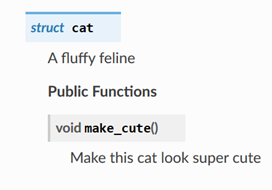
Writing good documentation is hard. Tools can’t solve this problem in themselves, but they can ease the pain.
This post will show you how to use Sphinx to generate attractive, functional documentation for C++ libraries, supplied with information from Doxygen. We’ll also integrate this process into a CMake build system so that we have a unified workflow.
For an example of a real-world project whose documentation is built like this, see fmtlib.
Excellent article, I used this to document MOTIS utl module - cf. PR 25
This describes tools and techniques that can identify memory leaks in Long running Python programs:
- Is it a Leak?
- Sources of Leaks
- A Bit About (C)Python Memory Management
- Reference Counts
- Garbage Collection
- The Big Picture
- CPython’s Object Allocator (pymalloc)
Here is a visualisation of memory allocators from top to bottom (from the Python source Objects/obmalloc.c):
_____ ______ ______ ________
[ int ] [ dict ] [ list ] ... [ string ] Python core |
+3 | <----- Object-specific memory -----> | <-- Non-object memory --> |
_______________________________ | |
[ Python's object allocator ] | |
+2 | ####### Object memory ####### | <------ Internal buffers ------> |
______________________________________________________________ |
[ Python's raw memory allocator (PyMem_ API) ] |
+1 | <----- Python memory (under PyMem manager's control) ------> | |
__________________________________________________________________
[ Underlying general-purpose allocator (ex: C library malloc) ]
0 | <------ Virtual memory allocated for the python process -------> |
=========================================================================
_______________________________________________________________________
[ OS-specific Virtual Memory Manager (VMM) ]
-1 | <--- Kernel dynamic storage allocation & management (page-based) ---> |
__________________________________ __________________________________
[ ] [ ]
-2 | <-- Physical memory: ROM/RAM --> | | <-- Secondary storage (swap) --> |In this post, we will explore how Unix pipes are implemented in Linux by iteratively optimizing a test program that writes and reads data through a pipe.1
We will begin with a simple program with a throughput of around 3.5GiB/s, and improve its performance twentyfold.
Dwarf Fortress is one of those oddball passion projects that’s broken into Internet consciousness. It’s a free game where you play either an adventurer or a fortress full of dwarves in a randomly generated fantasy world. The simulation runs deep, with new games creating multiple civilizations with histories, mythologies, and artifacts. I reached out to him to see how he’s managed a single, growing codebase over 15+ years, the perils of pathing, and debugging dead cats. Our conversation below has been edited for clarity.
I reached out to Tarn Adams to see how he’s managed a single, growing codebase over 15+ years, the perils of pathing, and debugging dead cats. Our conversation below has been edited for clarity. If you want more, we also spoke with Tarn on the podcast.
